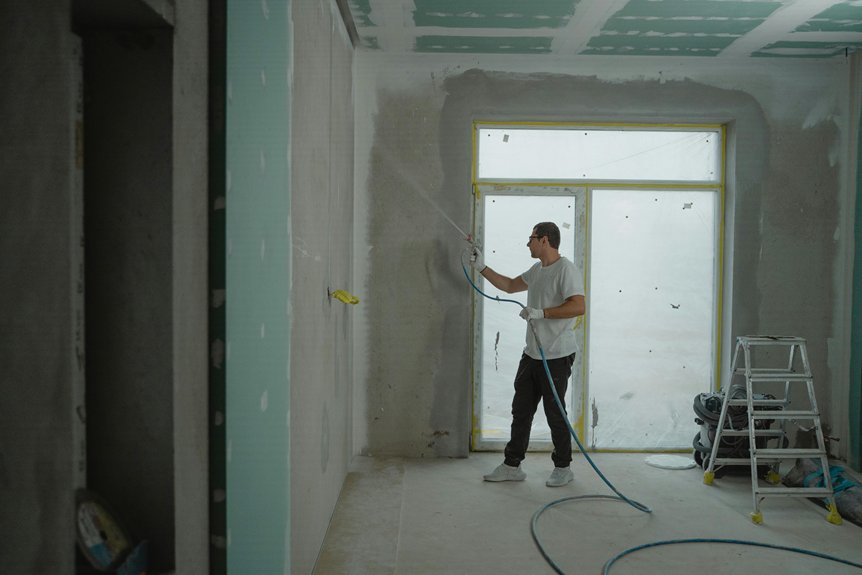Maintaining a log home requires diligence and attention to detail. You need to conduct regular inspections to catch damage early, clean the logs and surrounding areas to prevent buildup, and keep an eye out for pests that can cause significant harm. Effective sealing and moisture monitoring are essential for longevity, while prompt repairs can save you from bigger headaches down the line. But what’s the best way to protect your home from the elements?
Key Takeaways
- Conduct regular inspections to identify signs of rot, insect damage, or moisture intrusion in log homes.
- Establish a cleaning schedule to prevent dirt and mildew buildup on the logs.
- Implement pest control measures and inspect for infestations regularly.
- Maintain a sealing schedule using appropriate materials to protect logs from moisture and pests.
- Monitor moisture levels and ensure proper ventilation to prevent decay and damage.
Conduct Regular Inspections

When it comes to maintaining your log home, conducting regular inspections is essential to catch potential issues early. Aim for a quarterly inspection frequency to assess the log condition, looking for signs of rot, insect damage, or moisture intrusion.
Pay close attention to the ends of logs and areas near windows and doors, where problems often arise. Document your findings and make repairs promptly to prevent further damage.
Clean the Logs and Surrounding Areas
To keep your log home in top shape, establish a regular washing schedule to prevent dirt and mildew buildup.
Remove debris like leaves and branches promptly, as these can trap moisture and lead to damage.
Regularly inspect the logs for any signs of wear or damage, ensuring your home remains protected and beautiful.
Regular Washing Schedule
A regular washing schedule is essential for maintaining the beauty and integrity of your log home. Implementing effective log washing techniques helps prevent dirt buildup, mildew, and damage. Washing seasonally not only enhances your home’s appearance but also protects the wood from decay.
| Season | Recommended Action |
|---|---|
| Spring | Deep clean, inspect for damage |
| Summer | Light wash, check for pests |
| Fall | Prepare for winter, seal logs |
Remove Debris Promptly
After establishing a regular washing schedule, it’s important to focus on removing debris promptly from your log home and its surrounding areas.
Regular debris removal prevents moisture retention and inhibits mold growth, essential for your home’s longevity. Make it a habit to clear leaves, branches, and dirt from logs, gutters, and decks.
Use a soft broom or blower for gentle cleaning, ensuring you don’t damage the wood. Incorporate these maintenance tips into your routine: inspect areas after storms and seasonal changes.
Keeping your log home free from debris not only enhances its appearance but also protects its structural integrity.
Inspect for Damage
While regular maintenance is essential, inspecting your log home for damage is equally important to affirm its long-term health. Start by cleaning the logs and surrounding areas to affirm a thorough damage assessment. Look for signs of rot, insect infestations, or water damage, as these can compromise log integrity. Here’s a quick checklist to help you:
| Inspection Area | Action Required |
|---|---|
| Logs | Check for cracks and discoloration |
| Roof | Inspect for debris and leaks |
| Foundation | Look for settling or cracks |
| Windows/Doors | Affirm proper sealing |
| Surrounding Vegetation | Trim back any overgrowth |
Addressing issues promptly will protect your investment.
Check for Signs of Pests

How can you guarantee your log home remains a sanctuary rather than a breeding ground for pests?
Start by employing effective pest identification techniques. Look for signs like droppings, damaged wood, or tiny holes, which indicate infestations. Regularly inspect the interior and exterior of your home, especially areas where wood meets soil.
Utilize prevention strategies such as installing barriers, maintaining proper drainage, and keeping firewood stored away from the house. If you notice any pests, act quickly to address the issue before it escalates.
Staying vigilant assures your log home stays protected and pest-free, allowing you to enjoy your space worry-free.
Maintain Proper Sealing
Maintaining proper sealing is essential for protecting your log home from moisture and pests.
You’ll need to choose the right sealing materials that suit your climate and wood type, ensuring a long-lasting barrier.
Establishing a regular maintenance schedule will help you stay ahead of any issues and preserve the integrity of your home.
Importance of Sealing
Proper sealing is essential for preserving the integrity of your log home, as it acts as the first line of defense against moisture intrusion and pest infestations.
By employing effective sealing techniques, you not only protect your logs but also enhance energy efficiency and prolong the lifespan of your home.
Regular maintenance guarantees that any wear or damage is addressed, maximizing sealing benefits.
A well-sealed log home minimizes the risk of costly repairs and creates a comfortable living environment.
Prioritizing sealing will help maintain your home’s aesthetic appeal while safeguarding it from the elements and unwanted intruders.
Sealing Materials Options
Choosing the right sealing materials for your log home is essential, as they directly impact the effectiveness of your maintenance efforts.
Consider these sealant types:
- Caulks: Ideal for small gaps, easy to apply with a caulking gun.
- Chinking: Perfect for larger spaces between logs, providing flexibility and insulation.
- Sealants: Available in various formulations, offering durability and weather resistance.
When applying these materials, pay attention to the surface preparation and drying times to guarantee a secure bond.
Mastering the right application techniques will enhance the longevity of your log home’s seal, protecting it from the elements for years to come.
Regular Maintenance Schedule
A regular maintenance schedule is essential for preserving the integrity of your log home’s sealing. Incorporate seasonal checkups into your routine to catch any issues early. Use a maintenance checklist to guarantee you cover all necessary tasks.
| Season | Task |
|---|---|
| Spring | Inspect and reseal joints |
| Summer | Check for pests and moisture |
| Fall | Clean gutters and downspouts |
| Winter | Monitor insulation and drafts |
Monitor Moisture Levels
While maintaining the integrity of your log home, regularly monitoring moisture levels is vital to prevent decay and damage.
Effective moisture measurement helps you identify areas of concern before they escalate.
Here are key strategies for humidity control:
- Use a hygrometer to measure indoor humidity levels regularly.
- Guarantee proper ventilation in attics and crawl spaces to reduce moisture buildup.
- Check for leaks in roofs, gutters, and plumbing that may introduce excess moisture.
Repair Damaged Logs Promptly
When you notice any signs of damage to your log home, addressing them promptly is essential to preventing further deterioration.
Start by evaluating the extent of the damage. For minor issues, consider wood treatment options that can help restore the logs’ integrity.
If the damage is severe, you may need to implement log replacement strategies to guarantee structural stability. Make sure to choose logs that match the original wood for a seamless look.
Protect the Roof and Gutters

After addressing any damage to your logs, it’s important to turn your attention to the roof and gutters, as these elements play an essential role in your home’s overall maintenance.
Regular roof maintenance and gutter cleaning can prevent costly repairs down the line. Here’s what you should focus on:
- Inspect the roof for missing shingles or wear and tear.
- Clean gutters regularly to guarantee proper drainage and prevent water damage.
- Trim overhanging branches to avoid debris buildup and potential punctures.
Conclusion
By following these seven essential steps, you can guarantee your log home remains beautiful and structurally sound. Regular inspections and cleaning keep it in top shape, while pest control and proper sealing protect against damage. Monitoring moisture levels and repairing any issues promptly will prevent costly repairs down the line. Don’t forget to safeguard your roof and gutters, as they play an important role in your home’s overall health. Stay proactive, and your log home will thrive for years to come.

